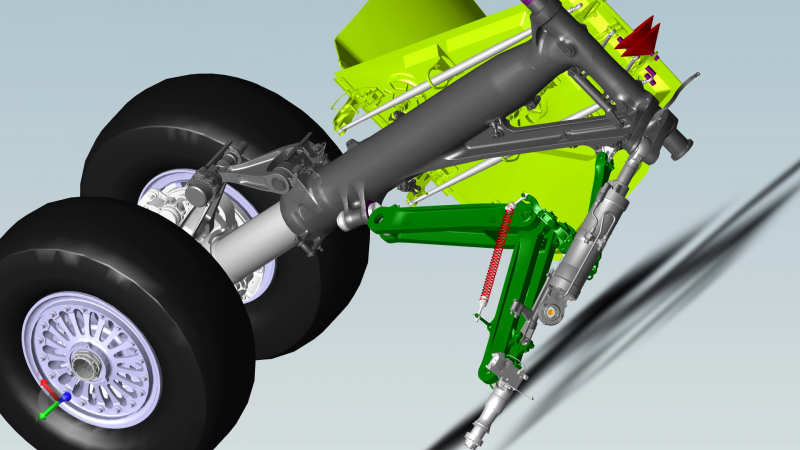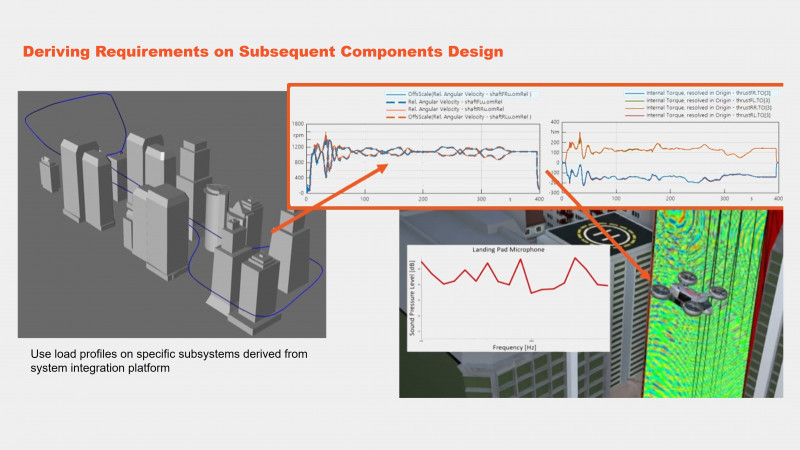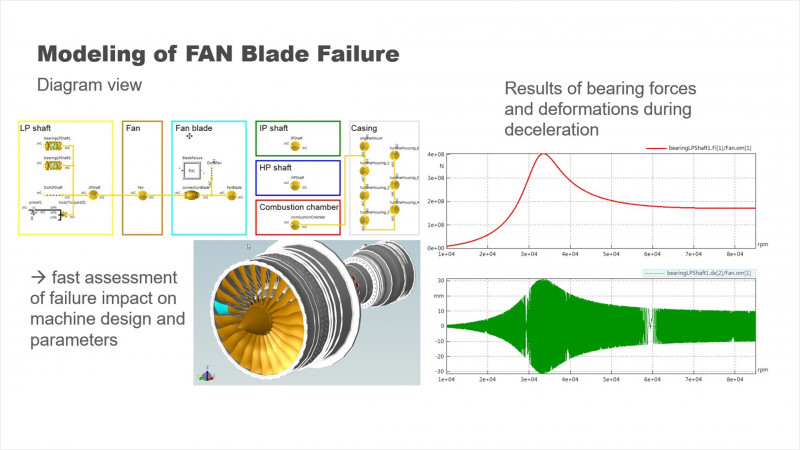Enhancing Aerospace Development with Model-Based Systems Engineering
What can System Simulation with ESI SimulationX bring to the Aerospace Domain Engineering Lifecycle?

As a multiphysics simulation approach for analysis of the dynamic behaviour of systems, and systems of systems, system simulation will bring valuable insights throughout the design and scenario-based virtual verification of cyberphysical or mechatronic products. Whenever physics (“meaning” or behavior) is added to abstract models of complex systems to bring your product to life, system simulation is your choice!
Located on the left side of the development cycle (V-Model), system simulation is the key integrator between architecture definition and geometrical design (CAD, FEM), providing proof and confidence in performance for a certain decision in typical large architecture design spaces. Using these simulation methods supports the paradigm of “doing the first time right", thus saving development and rework time and costs.
With advanced twin concepts based on ESI's Hybrid AI technology, such physical models are heavily reused in later stages of the lifecycle when combined and augmented with measurement data from the field to optimize product operation and lifetime, triggering “lessons-learned-feedback” into the conceptual design phase.
What is Model-Based Systems Engineering (MBSE) Software Used for in Aerospace?
Considering these general facts apply to all industry domains, aerospace use cases for system simulation may span a variety of technical systems and components embedded in model-based systems engineering processes - from generic modeling covering all physical domains (as demonstrated by various sample models), to specific system applications and scenarios. Here's an overview about 3 key applications for the system simulation software SimulationX.
Ensure Safety Certification for Electrified, Autonomous Air Vehicles Using MBSE

Urban air mobility mission scenario considering detailed wind conditions from 3D CFD simulation
Electrification and autonomous vehicles are important ingredients to approach present and future mobility challenges, particularly in increasingly condensed urban environments. Extending traffic into the 3rd dimension will allow for higher throughput, but requires safe integration into our daily life. Dedicated ESI solutions enable the virtual verification of various aspects coming into play, from designing such vehicles to their operation in piloted or autonomous mode in urban surroundings.
Combining the powerful aerodynamic base elements from the flight dynamics library with common subsystem types enables the model-based engineering, design and verification of typical aircraft systems like flight control systems, propulsion, actuation, or electric subsystems for airplane or rotorcraft (e.g., eVTOL) configurations.
Adapting detailed environmental conditions improves the system verification in challenging setups and scenarios like propulsion system failure and corresponding flight safety.
In particular for urban air mobility (UAM) applications, noise is a crucial aspect of meeting ambitious standards for potential certification. This performance data, as a natural result of system simulation, will directly feed into such 3D analysis topics, shifting component certification from “lab-like testing” to realistic scenario-based simulation credits.
Hence, system simulation serves as the base for modeling technical systems but also provides a valid multiphysics integration platform to develop corresponding subsystems like sensors and avionics. Moreover, complex scenario simulation, including traffic and weather conditions allows for analysis, verification, and optimization of the aircraft's operation and missions from safety-, comfort-, and efficiency perspectives (noise, energy consumption).
Analyze Bird Strike Scenarios Using Model-based Systems Engineering Software
Another example of virtual safety certification is the jet engine bird strike scenario and the analysis of the impact on engine and aircraft subsystems. The first level effect is mechanical vibrations exciting the whole drivetrain with fatal resonance frequencies. Subsequently, the thermodynamic process is harmed, and all aircraft systems driven by the engine are affected. System simulation and corresponding gas turbine models are an ideal way to gain fast multiphysics insights into these complex processes without the need for a long-time transient full FE simulation of the engine.
Systems Engineering Modeling and Simulation of Aircraft-Ground-Contact Scenarios

The holistic optimization of complex landing gear systems and actuation is a common MBSE use case
The holistic optimization of complex landing gear systems and actuation is a common MBSE use case of multiphysics system sizing and integration. Using hydraulics, pneumatics, 3D mechanics and controls libraries allows the quick build of very sophisticated models for designing and verifying complex actuation processes, while maintaining the computational performance of simulation real - or close to – depending on the desired model detail.
Specifically in this domain of “aircraft-ground-contact”, tire modeling is important and well-established in the automotive domain. Using these commercial, validated tire models, combined with the general system simulation domain types, enables the gaining of certification credits by simulation “overnight” in computationally heavy scenarios with hundreds or thousands of parameter settings like touchdown certification and aircraft behavior on uneven or unpaved runway. Even higher model accuracy is achieved by using flexible bodies based on reduced order 3D FE models in the mechanics domain.
What Can Engineers Do to Foster Traceability and Collaboration?
As traceability and collaboration are key aspects of today's engineering tools, even more relevant in safety-critical aerospace applications, ESI SimulationX provides a tool-agnostic, seamless integration into the customer engineering lifecycle and ecosystem, ensuring data consistency and digital continuity throughout the lifecycle. Aside from process safety, the efficiency and usability are significantly enhanced by reusing information from the system across all involved different (early stage) engineering domains, from requirements and architecture to automatically generate model templates and verification models, thus enabling more agile physical design processes. Here, system simulation with ESI SimulationX perfectly integrates with modern methodologies to manage product and process complexity like model-based systems engineering (MBSE).
What is an Opportunity to See Real-life MBSE Benefits and Use Case Examples?
As we look towards the future of aerospace engineering, it's clear that digital innovation and front-loading design are becoming pivotal in tackling engineering challenges. This evolution is driving a need for deeper engagement and collaboration within the system simulation community.
That’s why the SimulationX User Conference 2024: Hybrid Edition—provided a unique opportunity to meet and learn from industry experts and system simulation technology enablers. This event, hosted by ESI’s SimulationX core team Dresden/ Germany, featured a full 1-day program followed by an advanced training session on day 2, all designed to showcase digital success stories and provide a holistic view of technological advancements.
We encourage you to watch the brilliant presentations on-demand! Together, let’s pave the way for a future where digital innovation in aerospace engineering knows no bounds.
Graduated as an aerospace engineer, Marcel matured in compressor aerodynamics of jet engines (doctorate) before he joined ESI as a research associate for Systems Simulation. Still in charge of aerospace-related modeling and simulation topics, the core of his research activities moves continuously toward lifecycle integration topics applying model-based systems engineering methodology. Among various funded projects, like CleanSky2 MISSION, the outcomes feed directly into customer projects and prototypes for collaborative, continuous engineering platforms where Marcel represents the stakeholders' perspective supporting requirements and workflow definition to seamlessly integrate ESI solutions into established ecosystems.

